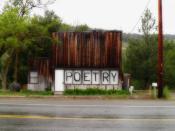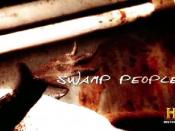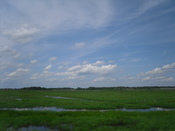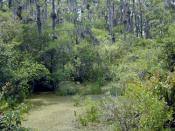The poem, ÃÂCrossing the SwampÃÂ is a well organized work of literature, which uses many techniques to develop the relationship between the speaker and the swamp. Some of these techniques include diction, narrative structure, repetition, imagery, personification, tonal shift, as well as many interesting sound devices.
Before the scrutinizing search for the figurative language begins, the first thing that is noticeable is the narrative structure. The speaker provides us with the image of the characterÃÂs footsteps itself through the structure of the poem, which indicates the struggle that he is going through by the gaps and indents throughout.
Because of the thoughtful syntax of the poem, we cannot refer the body as stanzas or paragraphs; thus, the poem itself is one broken stanza which includes the characterÃÂs adventurous journey and appalled misery. At the beginning of the poem, (line 5), the cacophonic sounds like branching, burred, belching bogs are used to describe the ugly sounds of the swamp as the character takes a step forward.
The repetition of ÃÂHereÃÂ is also very unique because it is emphasizing the location of where the character is being tortured by having to walk into this ruthless swamp.
The sound devices include consonance and rhythm with the repetition of the end sounds of pathless, seamless, and peerless. The ÃÂfoothold, fingerhold, mindholdÃÂ can be consonance as well as alliteration, as foothold and fingerhold both begin with the same sound. Alliteration also presents itself in lines 18 and 19 with ÃÂsuch slickÃÂ and ÃÂhipholes, hummocksÃÂ. There is another cacophonic sound in lines 21 and 22 as the speaker describes the image of the swamp with hatred, calling it a ÃÂblack, slack earthsoupÃÂ. This diction will also be considered as imagery as it compares the swamp with earthsoup.
The tonal shift in the poem begins on line 22, with the sentence ÃÂI feel not wet so much as painted and glitteredÃÂ ÃÂ From this point on, the speaker doesnÃÂt sound as frustrated and desperate as he was in the beginning of the poem. He finally feels hopeful and thankful to have another chance to live. The narrator also provides us with the description of the speaker, ÃÂa poor dry stickÃÂ, which tells the reader that the character is an old, fragile being, trying to cross this swamp that he gets angry at in the beginning but now is finally appreciative.
In conclusion, the relationship between the speaker and the swamp is of struggle. It seems like they both are fighting with each other to belittle the other and consume victory, but finally they give in to each otherÃÂs needs. The swamp lets the old man go, and he thanks the swamp heartily. The connection between them is of stubbornness and struggle, as well as understanding at the end.





